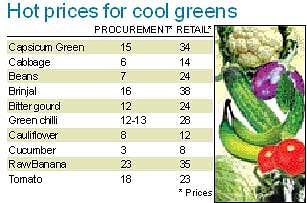Once felt to be a temporary escalation, the high prices are showing no signs of ebbing.
While some people trace the price to the gap between supply and demand, others blame it on lack of government intervention to check price rise. Despite the booming prices, the volume of business traded in various markets, retail shops and even push carts remains high.
Constantly haunted by the vagaries of the price rise, many families have begun to prune their spending on vegetables. “I have reduced my monthly spending on vegetables to manage family expenses,” says Uma, a resident of RT Nagar.
When contacted, Karnataka State Agricultural Marketing Board MD G Ramachandra said the phenomenon was not restricted to Karnataka alone. “While floods in various parts of the country have affected production, inflationary trends prevalent around the globe have also been a contributory factor. Further, shift from food crops to cash crops and other bio-fuel cultivation in agricultural lands and increase in consumption by the middle class has also influenced in this rise,” said Ramachandra.
A senior manager working for the Reliance Fresh in South India said demand and supply played a huge role in the fluctuation in the market. “Today tomato prices have come down by Rs 3 and beans crashed to Rs 10 to 12. With improved connectivity among mandis across the country, there is constant flow of vegetable across States and we have no control over the demand and supply,” he added.
No cheer for farmers
Paradoxically, while the citizens continue to pay more, the growers have not benefited. Farmers spread across the Devanahalli, Hoskote, Nelmangala, Dollaballapur and Jigini, the main production centers receive a pittance from procurement agents.
“I cultivate rose and carrot in my farmland. Last week I came to know that carrot price has risen to Rs 34 per kg. But I will get only a mere Rs 13 per kg for my produce,” said Ganeshappa, a farmer from Neeleri, near Devanahalli.
“Since middlemen want our produce at the lowest price possible, we are left with no option other than to sell for whatever price we get. We have no marketing mechanism to maximise returns. It would help if the government could introduce conveyance facility like one of the States recent established for fisherfolk to sell their catch,” said Ganeshappa.
Even though HOPCOMS and scores of private retailers like Reliance, Adithya Birla, Smart and Safal of late have started to procure agriculture produce directly from farmers, the latter have not benefited.. “We can’t give a higher price to farmers because we incur transportation costs,” said a senior procurement official with Reliance Fresh.
Inactive
According to a Karnataka State Agriculture Marketing Board official, farmers have not been proactive about engage in agricultural marketing activity. “We undertake frequent extension activities to educate farmers in agriculture marketing, but they are not ready to come to APMC-run markets in Yashwantpur, Kalasipalaya and Binnypet. As vegetables are perishable products, farmers have limited bargaining power,” he adds.
Horticultural Producers’ Co-operative Marketing and Processing Society Ltd (HOPCOMS) Purchasing Manager K Keshavamurthy said his organisation was trying to farmers their due. “We fix our rates based on the Kalasipalya market for vegetables and pass on the benefit of higher prices to 16,000 farmers spread across five districts in the State.”
